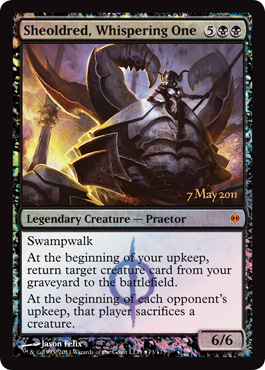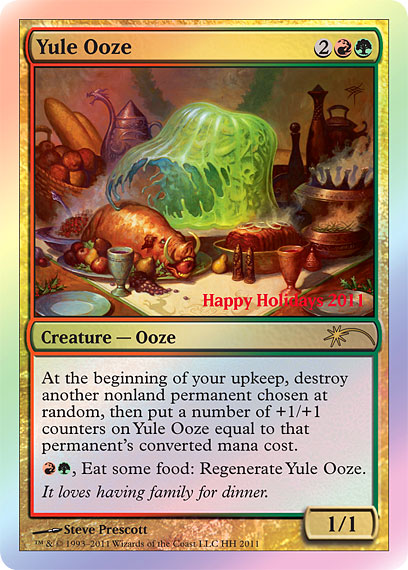Welcome back to what is becoming a quarterly blog! In all seriousness, though, I apologize for my lack of new material when I keep promising readers something to read. I keep lying and saying that I don't want this blog to be strictly about Magic. In truth, I'm afraid that I can't regularly come up with something new to write about on a regular basis. However, since I seem to be incapable of updating on a regular basis at all, why not go with what comes naturally?
Now, this is an article I've been wanting to do for some time, now. I'm a huge fan of Organized Play, and whenever I find the time and have to money to spend on beefing up a deck, I like to run in to the nearest Open. I myself typically play Legacy, and like so many others, I play Standard on Friday Nights at the Heroes Legacy comic shop. But what's the difference? What should you be playing? How tough is it to get into each one? These are the questions we shall attempt to address today.Firstly, there are two different methods of play sanctioned by the DCI: Limited and Constructed. Limited requires you to buy a certain number of packs, and then somehow build a deck with them. Constructed requires you to have a deck already built on hand.
Limited
Draft —Drafting can have anywhere between 4-18 players. The basic premise is that everyone gets 3 packs. On the Judges say, everyone opens their packs, discards their Rules Tips cards (and some House Rules have you discard your land), and chooses a card to keep. Then they pass the rest of pack to their right. And rinse and repeat. Next pack, same thing, except after you choose your card, you pass left. So on, so forth. Anything you pick is your deck and sideboard.
Drafting is the best way to show off your Magic prowess. You are given a small selection at a time, and are required to make critical, on the spot decisions. A fundamental understanding of not only the game concepts, but of central strategy and Block/Set themes is required to excel in this demanding format. So before you enter a draft, familiarize yourself with the sets being drafted, and just make sure you know what to look for. For more in-depth and frequent advice, see Limited Information, a Daily MTG column hosted by Steve Sadin (link below).
Ease of Entry: Anytime. Despite the need for skill to draft proficiently, beginners enjoy drafting too! It helps you learn the card in a set, and the set as a whole. This is a great way to move up in skill. And no matter how good you get, it always stays fun!
Sealed—Sealed events are similar to Draft, but a bit less challenging in some ways. Instead of 3 packs, you get 6 packs. You open all of your packs at once, and make a deck out of that set pool. This is easier because you already know what you have, and you can make a much more cohesive deck when you don't change your mind or stop getting cards you need halfway through. On the flipside, you have no control over what you get, and with any bad luck, your pulls may be horrible. Wizards has however made a huge leap in Limited, thanks to Mark Rosewater and Aaron Forscythe (He talks about it in his article New World Order). Sets and Blocks are now Limited-minded from Design onward, meaning Limited design now is Priority Numero Uno. So your worst Sealed Pool should still be playable, even if you can't think within the box for it.
Easy of Entry: Beginner-Intermediate. When you first dive into Limited, this is typically the preference of fresher players, as it minimizes the choices you have to make. Intermediate players appreciate the rarity structure, and the fact that because you get a larger pool, you can come out on top. But more Advanced players dislike the inability to pass unwanted pieces to another player in favor of things they need.
Constructed
Constructed is what we typically think of when we talk about playing Magic. There is a minimum of 60 cards to a deck, and can be as large as you want as long as you can shuffle it without assistance. There also cannot be more than 4 copies of and legal card, nor more than 1 copy of any Restricted card (Vintage Only). There are more formats for Constructed than Limited, each having a larger pool of cards than the last. For each format, see the Banned/Restricted List in the Resources link below.
| This "nobody card" helped Gaudenis Vidugiris make Quarterfinals at Pro Tour Nagoya |
Ease of Entry: Beginner. If you're new to constructed, this is probably the way to go. You don't have to know as many cards, so getting familiar with the field is pretty easy. It also makes building your deck, and acquiring those pieces all the easier. Unfortunately, as mentioned above, finding an Official Tourney in this format is hard, and those you will find are almost always Invitationals. Try holding a Casual Cup with it at the Kitchen Table!
| The most versatile card in Standard |
Standard also has a constantly shifting landscape. Each time a large Tour ends, a new deck pops up. Right now, the deck Dominating the field are Blue-Black/Esper Control, Wolf-Run Ramp, Red Deck Wins (RDW), Draw-Go, Solar Flare, Humans, Illusions, and Township Tokens. As of writing this article, these are the decks to beat. I would suggest at least familiarizing yourself with the decks. After all, know thy enemy.
Ease of Entry: Beginner-Intermediate. While this is easiest Constructed format to access, it's also the only regularly held tournament. You'll encounter all sorts of players at all sorts of levels. As far as grinding Experience in, this is the way to go.
| The Card that Killed a Format Well, one of them, anyways. |
| Part 2 of the Popular Grove of the Burnwillows combo |
Zoo, Affinity, Storm, Bant Control, Junk, Burn, and Melira Combo. Keep in mind that you may see these make up about 35-50% of the crowd, and every other person may be playing an original deck. Your best best is to find something your comfortable with, and build it. This is all about experimentation, now. So get at it.
Ease of Entry: Intermediate-Advanced. A good solid knowledge of the card pool, as well as competition in the area and deckbuilding skills are a good sized barrier to entry. However, once you have a tentative grasp on the subject, the best thing one can do is dive in headfirst. Learning it on the fly means you learn it more intuitively. You don't just read how it works, you see how it works, and you make it work. On the other hand, a good experience in Legacy will help you find your footing in an unstable metagame, where the decks are still vying for the Top Tier titles.
| Dark Horizons/Deeds |
| The King of Control |
Dredge, The Epic Storm (TES/ANT), Maverick, Sligh, Fish, NO RUG, Countertop, Stoneblade, Dark Horizons, Canadian Junk, Affinity, High Tide, Zoo, Tempo Thresh, and Team America.
You'll notice that some of the decks in Modern favor these slightly. That's true! When Modern started, the first places people ran for ideas were old Extended Decks and Proven and Established Legacy decks.
Ease of Entry: Intermediate-Advanced. Much like in Modern, there is a vast card pool to learn. Even though there are far more cards included in the format, the decks here are fairly consistent, and you need only really know the relevant cards unless making a "rogue" deck with some secret tech. For this reason, it's actually a bit easier to enter than Modern. This format will teach you valuable play tactics and decision making skills. Knowing the interactions and assessing outcomes is a must, so I do suggest you make yourself both familiar with the format, and somewhat proficient in Standard or Extended before attempting a full on rush into Eternals like Legacy or Vintage.
| One of the fabled Power Nine To date, the highest selling Trading Card |
From what I do know, if you don't feel like reading the article, or just like oing your own research, check out these Vintage decks:
Grim Long/Super Long, The Perfect Storm, Manaless Dredge, Gush, Oath of Druids, Stax, Suicide, Fish, MUD, Worldgorger Dragon, Beatz, Dark Times and BUG Landstill.
Ease of Entry: Advanced-Expert. You cannot play this format with out considerable prowess and planning skills. Decks must be hermetically sealed for power and spot answers. Don't let the Power Nine factor bum you out, though. Because of Vintage's nature, most Tournaments will allow a certain number of proxy cards. And you can use as many proxies as you want if you have the physical card to back it up. Most people won't play with a real Black Lotus or Moxen or Alpha Dual Land for fear of it getting damaged. This is generally pro-player territory, but occasional Opens are still held for enthusiasts and aspiring Vintage players.
Thank you all for reading! I hope you enjoyed the tour, and maybe even learned something. Be sure to check out the links below for more!
I'm not entirely sure what I'll write about next, so please feel free to leave suggestions in the comments, on my Facebook, or in my email!
Happy Spellslinging, everyone, and best of luck in your next tournament!
Resources:



No comments:
Post a Comment